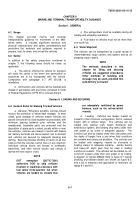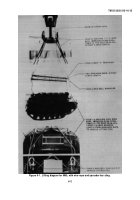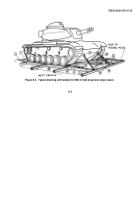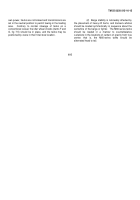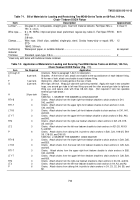TM-55-2350-215-10-15 - Page 43 of 66
TM 55-2350-21-10-15
next to the anchor fitting.
If the eight-link segment near
the anchor fitting is 1/2 inch or more longer than the
eight-link segment near the free end, the chain has
stretched beyond normal limits and should be replaced.
(b)
Flatcars manufactured by Thrall
Car Manufacturing Company are equipped with chains
that have an open hook attached to the free end of the
chain.
If all components are free of visible damage, the
eight-link segment next to the turnbuckle end of the
chain must be compared with the eight-link segment
next to the hook fitting at the free end.
If the eight-link
segment near the hook fitting at the free end is 1/2 inch
or more longer than the eight-link segment near the
turnbuckle end, the chain has stretched beyond normal
limits and should be replaced.
(5)
Each turnbuckle in the chain tiedown
assemblies must have adequate lubrication (grease,
MIL-G-10924, or equivalent) to assure smooth operation
during tensioning.
After tensioning is completed, 15 to
25 foot-pounds of torque must be applied to the jamnut,
and the bare threaded areas of the turnbuckle must be
lubricated to prevent rusting during transit.
(6)
The shackles and links for attaching the
chairs to the M60-series tanks are furnished with the
140-ton flatcar.
(7)
The ratchet-type handbrake lever is
located on the side of the car, below the level of the
deck.
In this position, the brake lever is operated from
the ground and does not interfere with loading or
unloading.
c.
General-Purpose Flatcar
.
The wood-decked
flatcar should be clear of used tiedown and blocking
materials, and the flatcar decking should be in sound
condition.
Loads discussed in this manual are based on
a flatcar that is 10 feet 4 inches wide, minimum.
7-5.
Loading M60-Series Tank on 68-Foot, 140-Ton,
Chain-Tiedown DODX Flatcar
a
.
The M60-series tank may be placed in the
tiedown position on the flatcar by a crane; or it may be
driven or towed, provided that a suitable ramp or bridge
is available.
Tanks are generally loaded facing forward,
in the same direction of intended transport.
b
.
Before the M60-series tank is loaded, the chain
anchors must be placed in the proper position as shown
in figures 7-1, 7-2, or 7-3.
Color coded positions are
provided on the flatcar for placement of tiedown anchors
for tanks.
White is M1 tanks; yellow is for M60-series
tanks.
Stenciled on these painted positions are the
tiedown attachment points on the applicable tank,
except for tanks that have the M9 bulldozer installed.
Stenciled attachment positions are illustrated in figures
7-1, 7-2, and 7-3, and described in tables 7-2, 7-3, 7-4,
and 7-5.
Chains attached to the anchors must be placed
in piles, in the center of the flatcar.
CAUTION
Do not place the tanks on, or drive
the tank over, the chains, turn
buckles, or chain anchors (damage
could result).
c
.
When two M60-series tanks are loaded (fig.
7-
1), the forward left-hand road wheel of tank No.
1
should be centered over the yellow mark on the left-
hand side, 154 inches (3.91 m) from the forward end of
the flatcar.
The last left-hand road wheel of tank No.
2
should be centered over the yellow mark on the left-
hand side, 154 inches (3.91m) from the aft end of the
flatcar.
Should the 140-ton flatcar arrive in the reverse
direction at the loading ramp, the tank will be loaded in
reverse and tied down as described in table 7-2.
When
one M60-series tank is loaded, the space between the
third and fourth left-hand road wheels should be equally
located over the center mark of the flatcar, 408 inches
(10.37 m) from either end (fig. 7-3).
d
.
After the M60 tank is loaded and placed in the
tiedown position, handbrakes should be set.
Lever for
transmission must be placed in neutral position.
7-2
Back to Top

